The 17 Greatest Picasso Paintings in 2025
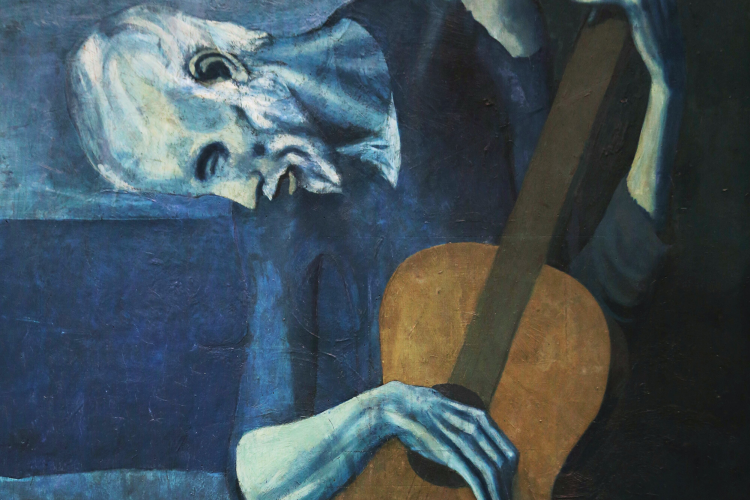
There are few objects in the art world as iconic and instantly recognizable as Picasso paintings. His name is synonymous with Cubism, a movement he helped start, though his talent extends into a host of styles and mediums.
Side-by-side with inventive Warhol paintings, graphic images from Piet Mondrian and the energetic Jackson Pollock paintings, Picasso paintings contributed to a trove of modern art that’s been treasured for generations. Over time, Picasso paintings have turned out to be some of the most valuable and imitated artworks ever created.
You may have seen Picasso paintings on television, in magazines or even in museums if you're a dedicated art fiend. You might even have prints or pictures from one the most famous painters hanging in your home. And you’ve surely heard of their enormous value, since word of Picasso paintings for sale always makes national news.
With such a broad body of work created throughout his lifetime, which Picasso paintings are the best examples of his expansive talents? We pulled together a virtual exhibit of our picks for the 17 greatest Picasso paintings to give a sampling of what this creative genius added to the modern art conversation.
Jump to Section
10 Facts About Picasso
1. He Helped Create the Cubist movement
If you indulge in art classes in the Bay Area, art classes in Houston, or art classes in San Diego, you may learn that Picasso pioneered Cubism, the distinctive flattened and angular look of his best-known paintings.
In fact, instructors in these expert-led classes are an excellent format for learning how to add a stroke of clever abstract creativity to your own works. If you can’t make it in person, online art classes are available to help you tap into your inner Picasso!

2. He Held His First Exhibit at Age 13
Considered a child prodigy, Picasso was showing off his considerable talents at an early age. By the time he was 13, he was ready for the first exhibit of his paintings.
These images gave patrons a glimpse into the already distinctive approach Picasso took to his creativity. His natural abilities led him away from art school before he finished, guiding him to Paris at 19 years to continue his creative adventures.
3. He Was Also a Sculptor
You may be familiar with Picasso paintings, but did you know he was a sculptor, too? In his lifetime, he completed nearly 3000 ceramic pots—the equivalent of creating 11 pots every day for his entire life.
One of his whittier creations, “Bull’s Head”, is made from a simple combination of bicycle parts; a pair of handlebars serves as the horns, crossing behind a saddle-shaped seat that represents the skull. It’s a study in minimalistic genius and rivals Picasso paintings as one of his most imaginative works.
4. His Full Name Is 20 Words Long
The most fascinating answer to the question “What are 10 facts about Picasso?” may be the first 10 words in his full name. You may know him as Picasso or even as Pablo Picasso, but his birth name is actually Pablo Diego José Francisco de Paula Juan Nepomuceno María de Los Remedios Cipriano de la Santísima Trinidad Ruiz y Picasso.
It’s no wonder he shortened it; using his full signature on Picasso paintings would have required a second canvas!
5. His Works Represent an Array of Distinct Styles
Though the painting techniques displayed in the best-known Picasso paintings include abstract and Cubist styles, he also worked with impressionism, surrealism, classical portraiture and almost graphic design-like images.
These canvases are expertly executed, though many aren’t as well known as the famous abstract Picasso paintings that capture his vivid imagination and innovative artistic expression. His ability to dip in and out of different styles is best summed up by one of his most famous quotes, “Learn the rules like a pro so you can break them like an artist.”

6. His Famous Blue Period Was Inspired by a Friend’s Death
After his friend Carlos Casagemas took his own life in 1901, Picasso paintings entered what’s known as his Blue Period. These images included portraits of deceased figures, with colors that saturated his canvases in watery blue and aqua tones.
The artist himself stated later that he started using blue hues after his friend's tragic passing. The emotional depth this palette added to his normal vibrant works launched a more subdued aesthetic that became one of the most recognizable and celebrated eras of Picasso’s painting career.
7. He Holds the Guinness World Record for Being the World’s Most Prolific Artist
In addition to the staggering level Picasso paintings’ prices have reached over the decades, the sheer quantity of his pieces makes him a record-setting artist.
With 13,500 paintings completed in a career that spanned a whopping 75 years, Picasso also made 34,000 illustrations, 100,000 engravings and prints, and 300 sculptures. Even for such a creative mind, Picasso’s output represents a truly massive body of work.
8. He Considered Van Gogh an Inspiration
Did Picasso like Van Gogh? Yes indeed! In addition to impressionist Paul Cezanne, Picasso viewed the famous Van Gogh paintings and viewed the Post Impressionist works as a distinct influence on his own works.
The overlap can be seen in Picasso’s earlier canvases, works like “A Spanish Couple in Front of an Inn” and “Portrait of Aunt Pepa”, both of which show a preference for heavy stroke work and a loose realism similar to Van Gogh’s signature works.
9. He Was Deeply Influenced by Art From Africa
Design elements in Picasso's abstract style reflect his reverence for indigenous African art; the presentation of flattened faces and the spiritual energy found in African imagery gave the artist a new perspective for his own creations.
In particular, Picasso was struck by a carving from the Congo he encountered during a visit to France, a gift delivered to writer Gertrude Stein by painter Henri Matisse, as well as masks seen during a visit to the Trocadero Museum. Though this sort of creative cultural appropriation stirred controversy, some of Picasso’s best-known works still reflect the influence.
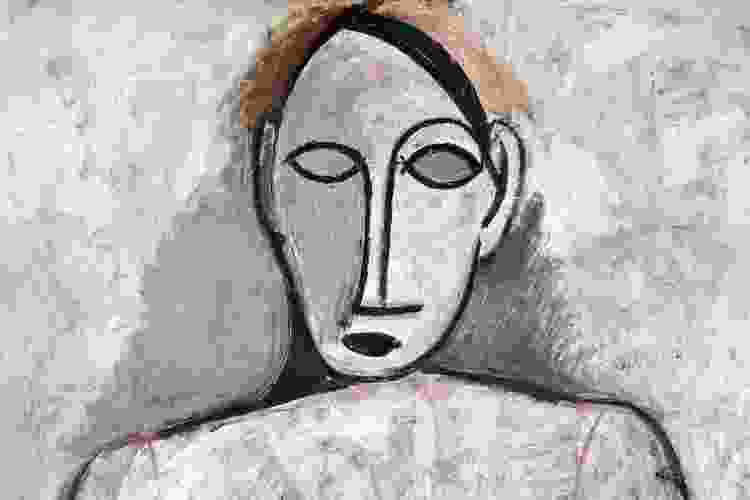
10. He Lived to the Age of 91
Despite his notoriously prickly personality and hedonistic lifestyle, Picasso lived a rich and creative life until his death at age 91. Unlike many of his contemporaries who succumbed to the sometimes-fatal struggles of the creative lifestyle, Picasso was able to extend his career to a 75-year run, an incredible span that any artist would love to claim.
His longevity gave him time enough to experiment with as many styles as he needed to express his imaginative vision.
Picasso's Greatest Paintings
1. Guernica (1937)
Ask art experts “What is Picasso's most famous piece?” and they’re likely to name “Guernica” as the most famous of all Picasso paintings. Completed in 1937 and depicting the ravages of the Spanish Civil War, this haunting tableau is the apex of Picasso’s talents, a flattened vantage of the carnage that took place when German and Italian air forces attacked the Basque city of Guernica.
In the image, twisted figures of humans and animals cry out in anguish the viewer can practically feel, thanks to Picasso’s incredible talent for using Cubist principles to bring raw emotion to his art.
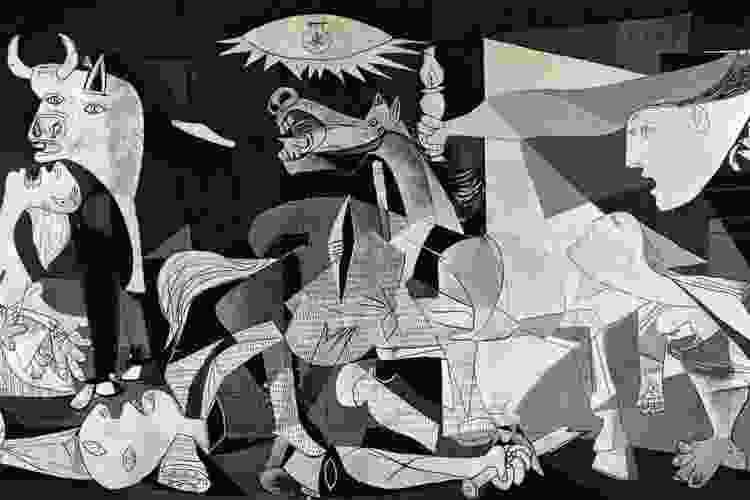
2. Girl In Front of Mirror (1932)
Despite his personal views on women being largely misogynistic, Picasso found great inspiration painting women, especially in his puzzle-like Cubist images such as “Girl In Front of Mirror”. This vibrant piece from 1932 uses mesmerizing patterns and vibrant hues to portray an abstract young woman admiring her own beauty.
The playful Cubist aspects of the best-known Picasso paintings add whimsy, while bold color choices bring the image into the realm of now-familiar pop art, a format which the best-known Picasso paintings helped usher in. The original sold for over $179 million, a record among Picasso painting prices.
3. The Old Guitarist (1904)
In contrast to the scattered composition of the most famous abstract Picasso paintings, “The Old Guitarist” is a portrait that adheres to relatively traditional structure for his human subject.
Painted in Barcelona during his Blue Period between 1903 and 1904, the canvas portrays the sorrow of an elderly musician dressed in tattered clothing as he plays his instrument in the street. The contorted pose and mournful expression on the man’s face gives the viewer an undeniable sense of sorrow, showing the dignity of poverty with which Picasso himself was well-acquainted.
4. Self-Portrait (1901)
This striking canvas may not be among the more famous pictures of Picasso paintings you’ve encountered, but it’s every bit as powerful as his better-known works. Rendered in a more realistic style, this Picasso painting shows the artist as a younger man, his steely gaze fixed directly at the viewer.
The royal blue backdrop surrounding his deep black hair, alabaster skin and navy blue overcoat buttoned up to the chin are a stark presentation of a 20-year-old Picasso as a ghostly presence.
This image, completed in Paris in 1901, was the first of his Blue Period paintings. It’s a reminder that when he painted in a more realistic style, Picasso’s art had a knack for making direct visceral connections with viewers.
5. Les Femmes D’Alger (1934)
“Les Femmes D’Alger”, or “The Women of Algiers”, is not only one of the most famous Picasso paintings in the world; it’s also one of Picasso’s most expensive paintings, with a price tag of a mind-boggling $139 million.
Though the lines are bold and the women expressively portrayed in a variety of nude figurative styles, the colors are a spectrum of candy-colored hues that make the canvas feel like a celebration. Contrasted with geometric sections of blackened negative space, the splashy tones invite the viewer to join the party.
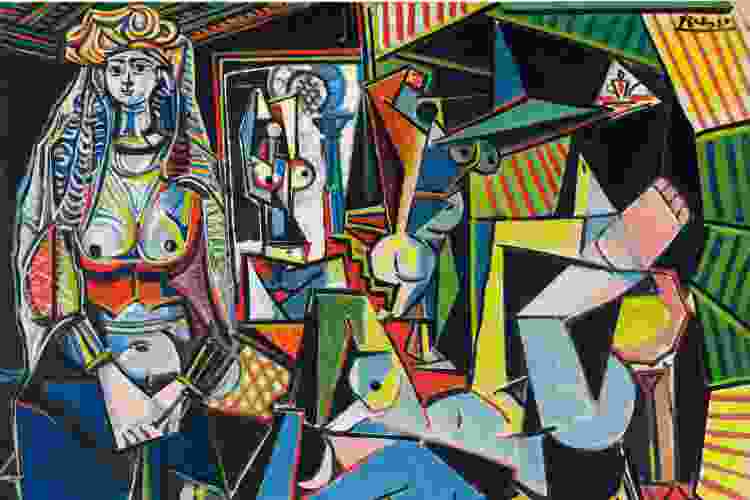
6. Ma Jolie (1911)
This 1911 piece is one of the more conceptual Picasso paintings, taking the idea of abstraction to the extreme. The title implies a tribute to Marcelle Humbert, a Picasso paramour who he called “ma jolie,” a French term of endearment.
With its scattered angles suggesting an M.C. Escher-like labyrinth of doorways and passages piled on top of one another, it has the quality of viewing an ancient city through a kaleidoscope.
Flashes of light illuminate a darker background, with golds and earth tones taking over the canvas and bolder outlines intersecting with glyph-like inscriptions scattered about.
7. Portrait of Dora Maar (1937)
In a more familiar portraiture style that fans of Picasso paintings will easily recognize, “Portrait of Dora Maar” is an homage to a photographer who became part of the painter’s life in 1936.
His Cubist imagining of the woman is a flattened face bearing a mischievous smile, with her awkwardly-positioned hand propping up her cheek on the arm of a crooked chair.
Her brightly-colored blouse and vibrant skin are the only color in an otherwise-muddy palette, placing her squarely in the artist’s spotlight. Though there’s clearly more depth regarding the subject being hinted at, the colorful sketch lends a touch of whimsy to the list of “Top 10 Famous Picasso Paintings” and stands as a masterwork, akin to a Mona Lisa in subject and presentation.
8. The Weeping Woman (1937)
Another depiction of Dora Maar, “The Weeping Woman” is one of the more frightful Picasso paintings, almost a Dia de Los Muertos máscara of a woman whose face appears fractured in grief. The central section is gray and skeletal, her teeth visible in an obvious grimace and her cheeks stained with tears.
The outer section is a contrast in color and form, showing smoother contours filled with rich primary colors. The detail in Picasso’s imagining of his lover’s sorrow invites the viewer’s eye to travel from space to space before taking in the painting as a whole. The stunning originality makes this one of Picasso’s most famous paintings.
9. Le Rêve (1932)
“Le Rêve” isn’t simply one of the most exciting Picasso paintings ever; it’s also among his most winsome, a joyful full-color sketch of an abstract female figure caught mid-dream. She sits upright in a bright red wing chair, a calligraphic smile across her moon-white face.
The rotund shapes and blocks of cheerful color set against a flower-pattern wallpaper are the abstract equivalent of a children’s picture book illustration. The highly-coveted Picasso painting was sold by its previous owner, hotel magnate Steve Wynn, for a sweet $155 million, after repairing a small puncture he caused in the canvas. Imagine damaging a Picasso painting and still selling it for such a stunning price!
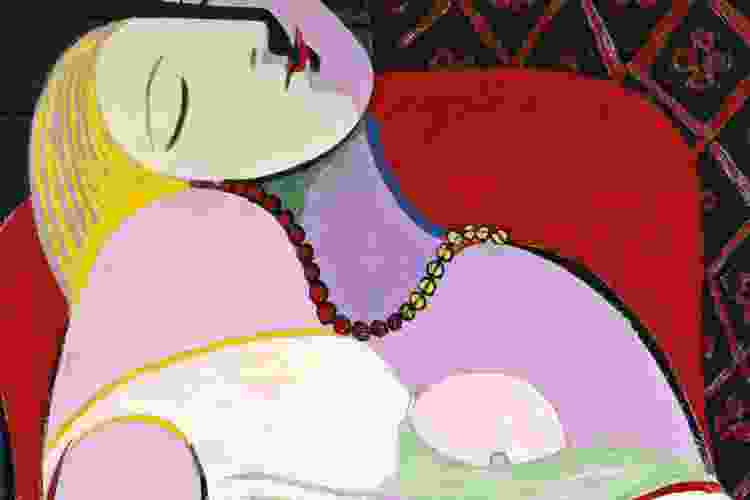
10. Bathers (1918)
Many Picasso paintings possess a sense of naïve wonder in their portrayal of human figures. With “Bathers”, the artist once again shows a playful glee he took in capturing the joy of three bathing beauties lounging on the beach like sirens luring a sailboat in the distance to the rocks on the shore.
Though their poses and expressions are a play on classical images like Venus Rising, their elongated limbs and exaggerated positioning depict a forced elegance, as if the abstraction of beauty results in even more voluptuous torsos and graceful limbs to twist into position.
11. The Acrobat’s Family With Monkey (1905)
This Picasso painting is as oddly surreal as the title suggests. Though sincere in its form and presentation, the costumed figure posed with their Renaissance-like child and a monkey sitting beside them.
The delicate stroke work and careful lines express a romantic sensibility similar to Edouard Manet, a Picasso contemporary whose work had a definite influence here. Pastel washes emphasize a palpable tenderness; even the monkey looks on reverently as the family adores their child, showing how delicate Picasso could be when portraying his subjects.
12. Woman With Book (1932)
One of the softer cubist visions among Picasso’s paintings, the woman in “Woman With Book” appears to be carved roughly out of wood, her features angular and askew. With no bold outlines to contain the shapes, the woman’s body achieves soft curves and sloping contours, courtesy of alternating gray and taupe tones used to cast light and shadow.
Darker tones used to create her hair mirror the geometric cover over her book, drawing the viewer’s eye from the top of the canvas to the bottom as well-spaced focal points. It’s a romantic take on this jaunty style that future painters would emulate extensively.
13. Femme à la Montre (1932)
How much is a Pablo Picasso painting worth? Some, like “Femme a la Montre”, are worth as much as $139 million. As the second-most expensive of Picasso’s paintings, this image is a perfect capture of the exciting energy of the Cubist movement.
Using primary and secondary colors, the artist creates a coloring book-style portrait of a well-dressed and manicured woman seated in a chair, her features illustrated in a jumble of rounded shapes. Her visible eye stares with winning confidence, inviting the viewer to appreciate her beauty as it is rather than judging its unconventional presentation. It’s a witty display that feels custom-crafted to draw smiles and inspire happiness.
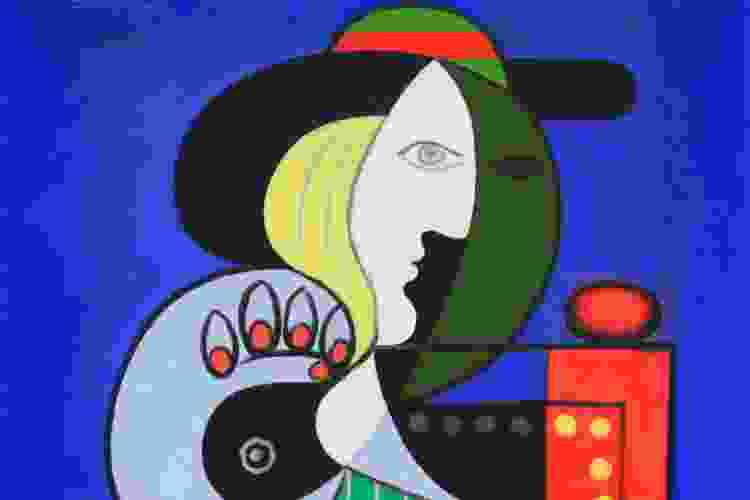
14. A Spanish Couple in Front of Inn (1900)
Van Gogh’s influence is clear in this richly textured Picasso painting, with its soft edges, vibrant colors and soft-edge dreaminess. Unlike his abstract works, this glowing image doesn’t require interpretation; a well-dressed couple stands before a rustic inn, the woman smiling in happy conversation with her partner.
Villagers mill about behind them, with a sun-soaked tree shining on a hill in the background. Romantic, warm and comforting, it’s a masterwork of color placement and controlled brushwork.
15. Garçon à la Pipe (1905)
There is an almost religious treatment of the lone figure in this Picasso painting, a flower-crowned young man holding a smoking pipe while gazing off at an angle with shadowed eyes. The floral pattern on the wall behind him mimics the wreath in his hair.
The figure’s elongated torso and limbs add interest to his slightly skewed but otherwise anatomically correct facial features, building a mystery that the viewer may try to solve, but the significance of which only the artist knows for sure.
16. Figures at the Seaside (1931)
If a Picasso painting could be considered wacky and sensual at the same time, “Figures at the Seaside” would be a prime example. The figures from the title appear as abstract sculptures embracing on the beach, a tangle of oddly-shaped limbs and misplaced features.
Their distinctive shading creates an inviting depth that relates their forms as they embrace with cartoonish intensity. The simplistic treatment of the sea and shore in the background places them in a setting that feels unfinished, pushed aside in the presence of their amorous display.
17. Cat Catching a Bird (1939)
Though the subjects are fully recognizable in “Cat Catching a Bird”, the treatment they’re given in this Picasso painting shows how the artist’s sense of abstraction adds gritty emotion to even his simplest images. The cat’s demonic mask of an expression shows feral rage as his teeth dig into the wing of a blackbird in his clutches.
With child-like shapes, the bird is shown dying with its beak agape, its red flesh exposed beneath dark feathers. There’s a raw intensity here that works much better thanks to the bit of abstraction in the mix.
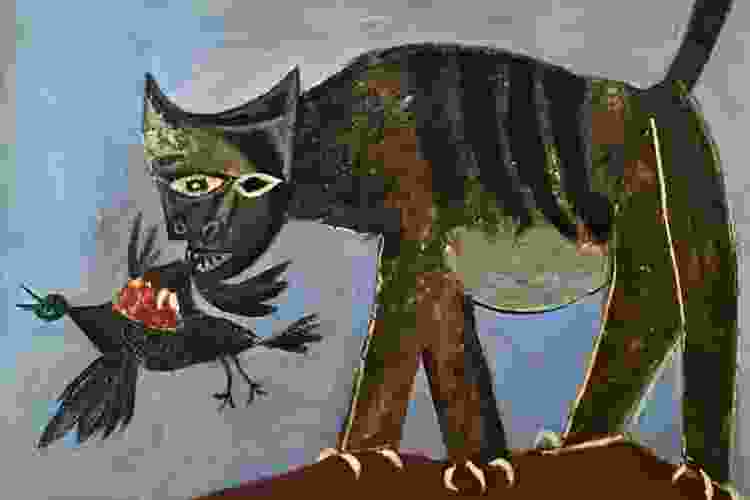
Using Picasso paintings as a model for simple abstract oil painting for beginners or even acrylic painting for beginners is a great way to get practicing artists acclimated to a looser style that’s easier to achieve. In fact, anyone hoping to learn how to start oil painting has a ready catalog of Cubist images in any of the “Top 10 Picasso Famous Paintings”.
The deceptive simplicity of what these paintings express lets new painters develop their own vision for modern art while learning from one of the founders of the movement. But even if you’re just an admirer of great art, Picasso’s paintings provide an exciting window into the mind of a true original, one who permanently altered the landscape of contemporary art.
For even more fun art ideas, check out other experiences happening on Classpop!


